

by Pauncho Billo
I gave up alcohol quite some time ago, but many moths and butterflies find it hard to resist, especially when the liquid is sweetened with some brown sugar and overripe fruit.
Adult Catocala are equipped with a proboscis, tongue or feeding tube that is normally coiled below the head. They use this structure, extended, to drink in energy and nutrient laden liquids like flower nectar, tree sap and the juices from fermenting fruit.
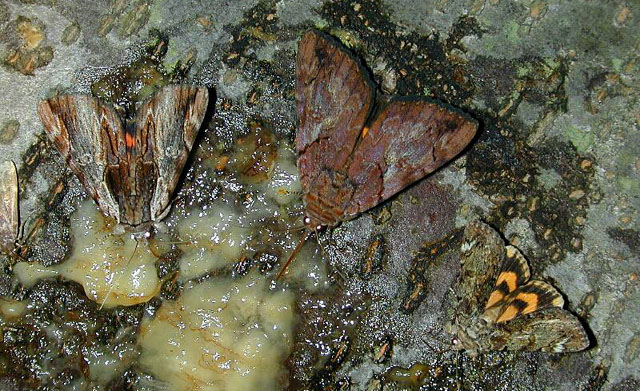
Catocala ultronia, Catocala muliercula and Catocala minuta
on fermenting tree sap
courtesy of Steve Walter, Floyd Bennet Field
(Jamaica Bay area of New York) July 6.
With a keen sense of smell, they are especially attracted to a mix of stale beer, brown sugar and overripe fruit.
Occasionally I will read on a website that it is necessary to let a "batch" ferment for a year. A simple recipe of brown sugar and beer, mixed up the day of its application, will work fine! Mixes with fermenting fruit usually only need a few days in the sun.
I like to use fruit in my bait, for the added texture and aroma. The beer is not even necessary. Experiment with different mixes to see what works best in your area.
When fruit ferments it produces alcohol. Addditonal sugar and yeast, added to the fruit, fuel the fermentation process. The sweet alcoholic smell of rotting apples, peaches, bananas, plums etc., probably lets moths know there is sugar filled liquid available.
Here are some recipes you might want to try. When you find one your "friends" like, double, quadruple, etc., the recipe. Just about any concoction will work as long as the sweet smell of sugar gets into the air:
1) Quick One: Mix one pound of brown sugar in sufficient beer to just dissolve all the sugar.
2) Peach supreme: Dice up a couple of overripe peaches, mix with a cup of brown sugar, a teaspoon of dry yeast (optional), a squirt of molasses (optional) and sufficient water or beer to dissolve the sugar. Let this mix stand in the sun for a few days. An ounce of rum never hurts any mix, but is not really necessary.
3) Whatever!: Chop/slice up any ripe or overripe fruit, mix with a cup of brown sugar and sufficient water, beer, fruit brandy, rum, etc., to just dissolve all the sugar. A teaspoon of dry yeast (optional) will help the fruit to ferment in the sun for a few days.
Be careful with your brew if you are fermenting fruit. Carbon dioxide and other gases will be released and could cause an improperly sealed ziploc bag to split due to greatly increased internal pressure.
Apply your mix with a paint brush or sponge a few feet up on the trunks of known hosts like oaks, hickories, walnuts, poplars, etc..You will want to use a number of trees, easily accessed in a short circuit that you can walk in fifteen minutes. Your earliest visitors will probably be ants and they may prove a disturbance to the desired guests. Paint an upper ring to satisfy those who are descending, a lower ring for those ascending, and a central patch for your intended guests. Catocala concumbens August 15-17, Ontario, courtesy of Tim Dyson. | 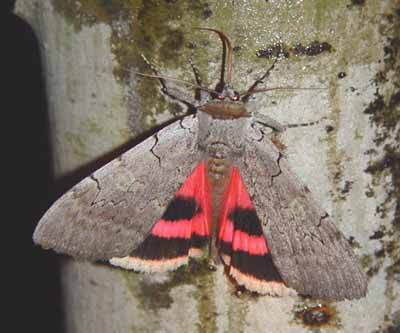 |
Tim Dyson picked up this lovely display of overripe fruit for free at a local Foodland grocery store. He writes, "...they gave me all the bad fruit I could take home with me. Steady supply now I`d say. Too bad I couldn`t convince them that their brown sugar and maple syrup had gone bad too,,,,,, expensive."
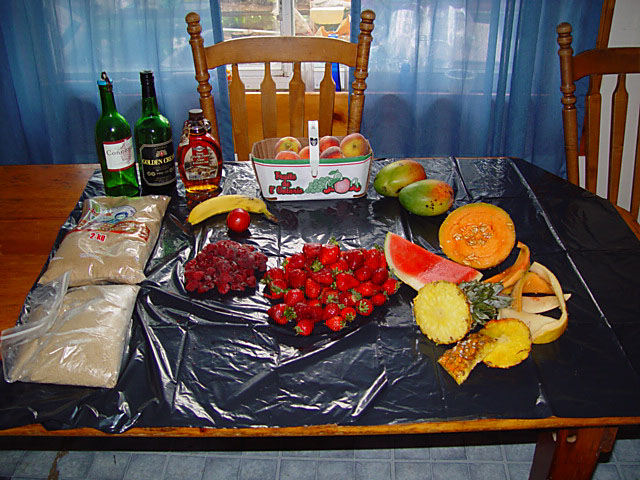
"Tim`s Berry Melon Catocala Cocktail"
1/2 litre smushed raspberries
1/2 litre smushed strawberries
1/2 litre smushed melons (I used three types of melons)
1 cup brown sugar
1 teaspoon yeast
2 tablespoons red wine
"Put in sun for two days, or in greenhouse for one afternoon, or cook until it starts to get warm, stirring as it warms, then let stand for 1-2 hours for yeast to do its thing, and then its ready.
"Use at least a 3 litre container for mix, or yeast will make you wish you had!
"The catocalas that come to this mix stayed on it for 50% longer than other recipes. I don`t know if it meant they liked it that much, or they had to drink that much in order to be satisfied. (I`m going with the former)"
Tim has also had great success with "five (very gone bad-almost brown) peaches, about 10 tablespoons of red wine added to 2 cups of brown sugar (that part tastes pretty good to this human), putting sugar into wine and gradually mixing to a thick, gritty paste, (I have to check the kitchen contents to recall some other odds and ends that went into it), about 4 tablespoons of yeast, a little (maybe 2 tablespoons) of stale ginger beer and a banana."
Tim got many interesting shots using the peach recipe:
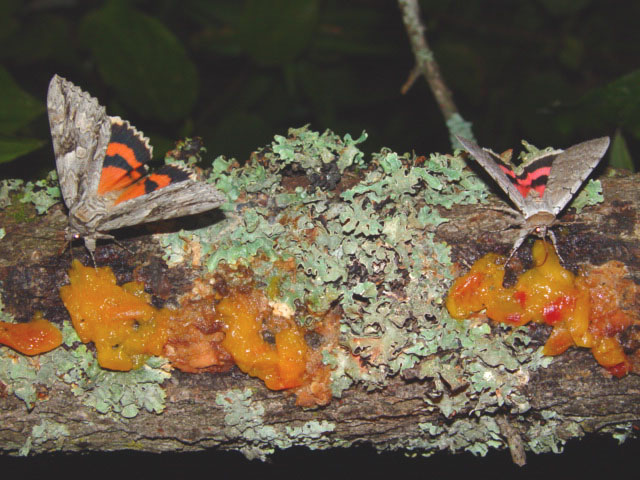
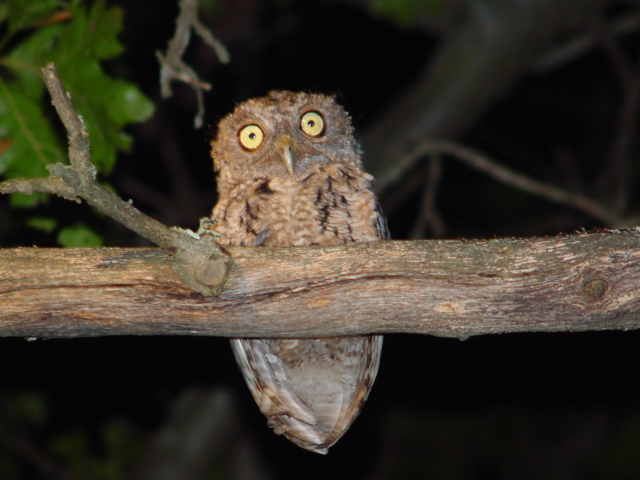
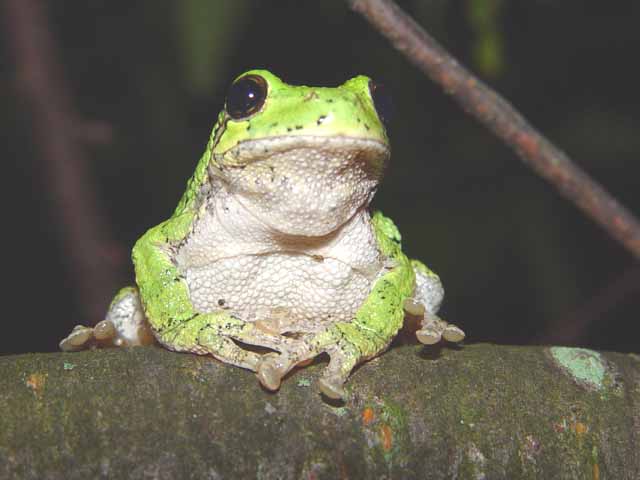
On August 27, 2004, Tim Dyson recorded thirty-five specimens of ten different Catocala species on his bait trail, using the following recipe:
3M, or Triple M, a.k.a. Maple Mango Melon
1 smushed Mango
1 cup smushed Melons (various types)
100 ml Maple syrup (pure, not that fake stuff)
4 heaping tablespoons Brown sugar
1 tablespoon fine Canadian Sherry (save the rest for a dinner party)
1 teaspoon yeast
Please note, these baits are fine for use after sitting only a day in the sun.
Use your browser "Back" button to return to the previous page.
Return to Main Catocala Index